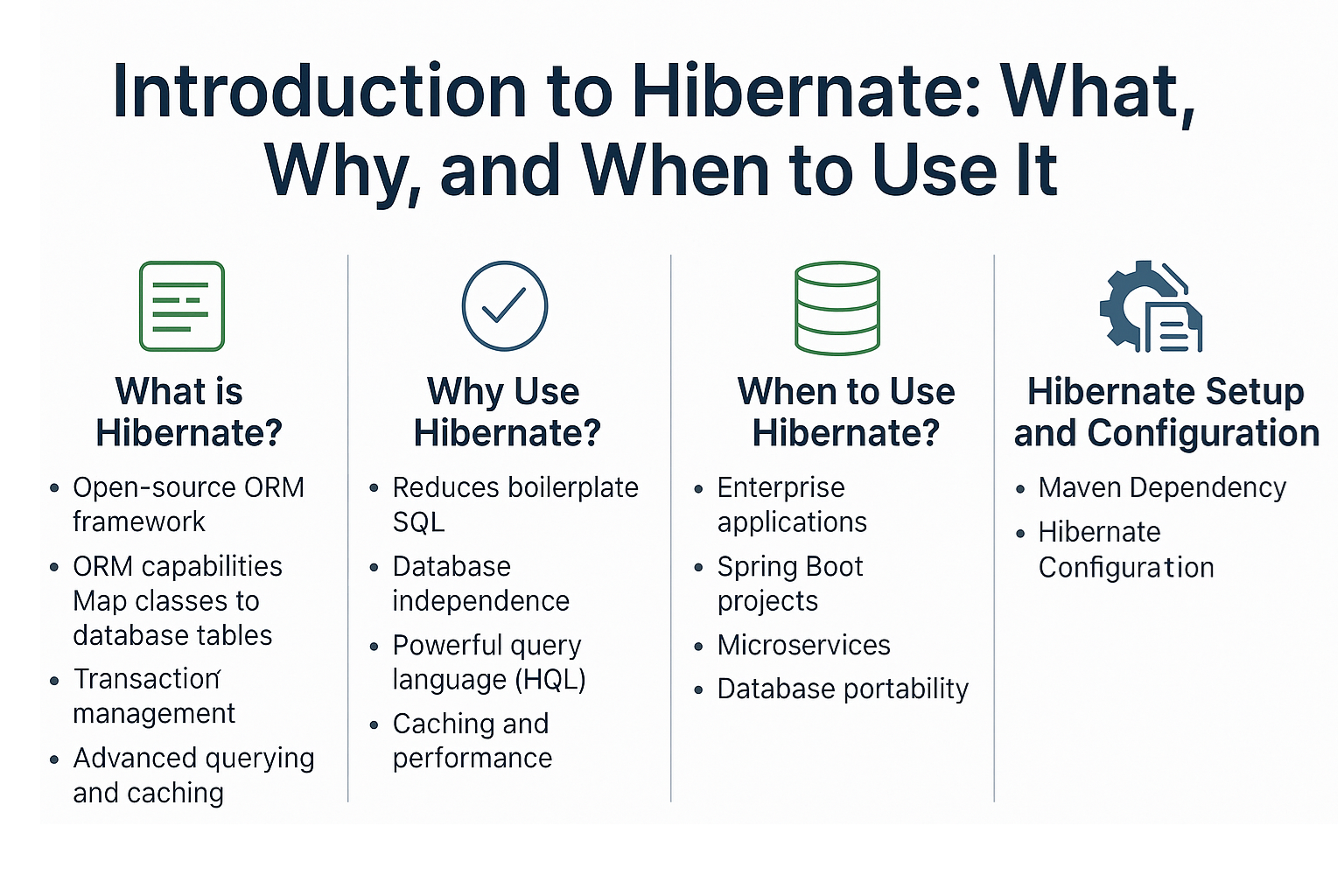Introduction
If you’re a Java developer, chances are you’ve spent time writing SQL queries to interact with relational databases. While powerful, this approach often leads to boilerplate code, database dependency issues, and difficult-to-maintain applications. This is where Hibernate comes in.
Hibernate is a popular Object-Relational Mapping (ORM) framework for Java that bridges the gap between Java objects and relational database tables. It automates the tedious task of converting between Java objects and SQL queries, allowing developers to focus on business logic rather than database plumbing.
Think of Hibernate as a translator: it converts your Java code (objects) into SQL for the database and vice versa, so you don’t have to write repetitive SQL manually. This improves productivity, maintainability, and performance.
What is Hibernate?
Hibernate is an open-source ORM framework that provides:
- ORM capabilities: Map Java classes to database tables using annotations or XML.
- Transparent persistence: Save and retrieve Java objects without explicit SQL.
- Transaction management: Handle ACID transactions seamlessly.
- Advanced querying: Use HQL (Hibernate Query Language), Criteria API, or native SQL.
- Caching and performance optimizations.
- Integration support with frameworks like Spring Boot and Jakarta EE.
Why Use Hibernate?
-
Reduces Boilerplate SQL
Instead of writingINSERT,SELECT,UPDATE, andDELETEstatements manually, you can perform operations directly on objects. -
Database Independence
Switch between databases (MySQL, PostgreSQL, Oracle) with minimal code changes. -
Powerful Query Language (HQL)
Write queries in an object-oriented way without worrying about SQL dialects. -
Caching and Performance
Hibernate uses first-level (session) and second-level caching to avoid unnecessary database hits. -
Relationship Management
Easily map complex relationships likeOneToMany,ManyToOne, andManyToMany.
When to Use Hibernate?
- Enterprise applications that require complex database interactions.
- Spring Boot projects where Hibernate integrates seamlessly with Spring Data JPA.
- Microservices needing persistence abstraction without boilerplate JDBC.
- Applications requiring database portability across multiple vendors.
Avoid Hibernate if:
- You need raw SQL performance (e.g., analytics, batch processing).
- Your project has very simple persistence needs where JDBC is sufficient.
Hibernate Setup and Configuration
Maven Dependency
<dependency>
<groupId>org.hibernate.orm</groupId>
<artifactId>hibernate-core</artifactId>
<version>6.4.1.Final</version>
</dependency>
Hibernate Configuration (hibernate.cfg.xml)
<!DOCTYPE hibernate-configuration PUBLIC
"-//Hibernate/Hibernate Configuration DTD 3.0//EN"
"http://www.hibernate.org/dtd/hibernate-configuration-3.0.dtd">
<hibernate-configuration>
<session-factory>
<property name="hibernate.connection.driver_class">com.mysql.cj.jdbc.Driver</property>
<property name="hibernate.connection.url">jdbc:mysql://localhost:3306/testdb</property>
<property name="hibernate.connection.username">root</property>
<property name="hibernate.connection.password">root</property>
<property name="hibernate.dialect">org.hibernate.dialect.MySQL8Dialect</property>
<property name="hibernate.hbm2ddl.auto">update</property>
<property name="hibernate.show_sql">true</property>
</session-factory>
</hibernate-configuration>
Hibernate Core Annotations
import jakarta.persistence.*;
@Entity
@Table(name = "students")
public class Student {
@Id
@GeneratedValue(strategy = GenerationType.IDENTITY)
private Long id;
@Column(name = "student_name", nullable = false)
private String name;
@OneToMany(mappedBy = "student", cascade = CascadeType.ALL)
private List<Course> courses;
// Getters and Setters
}
CRUD Operations with Hibernate
Create (Insert)
SessionFactory factory = new Configuration().configure().buildSessionFactory();
Session session = factory.openSession();
Transaction tx = session.beginTransaction();
Student student = new Student();
student.setName("Alice");
session.persist(student);
tx.commit();
session.close();
Read (Select)
Session session = factory.openSession();
Student student = session.get(Student.class, 1L);
System.out.println(student.getName());
session.close();
Update
Session session = factory.openSession();
Transaction tx = session.beginTransaction();
Student student = session.get(Student.class, 1L);
student.setName("Updated Name");
session.update(student);
tx.commit();
session.close();
Delete
Session session = factory.openSession();
Transaction tx = session.beginTransaction();
Student student = session.get(Student.class, 1L);
session.remove(student);
tx.commit();
session.close();
Querying in Hibernate
HQL (Hibernate Query Language)
List<Student> students = session.createQuery("FROM Student WHERE name = :name", Student.class)
.setParameter("name", "Alice")
.list();
Criteria API
CriteriaBuilder cb = session.getCriteriaBuilder();
CriteriaQuery<Student> cq = cb.createQuery(Student.class);
Root<Student> root = cq.from(Student.class);
cq.select(root).where(cb.equal(root.get("name"), "Alice"));
List<Student> students = session.createQuery(cq).getResultList();
Native SQL
List<Object[]> results = session.createNativeQuery("SELECT * FROM students").list();
Fetching Strategies and Caching
- Lazy Loading (default): Data is fetched only when accessed (like ordering food only when you’re hungry).
- Eager Loading: Data is loaded immediately (like ordering everything at once).
- First-Level Cache: Session-specific cache.
- Second-Level Cache: Application-wide cache using providers like EHCache, Infinispan.
Common Pitfalls and Anti-Patterns
- N+1 Select Problem: Fetching child entities in a loop → fix with
JOIN FETCH. - Eager fetching misuse: Loads unnecessary data.
- Improper cascading: Accidentally deleting child records.
Best Practices
- Prefer Lazy fetching by default.
- Use DTOs for API responses, not entities directly.
- Enable batch fetching to fix N+1 issues.
- Monitor with Hibernate statistics and tools like JProfiler.
📌 Hibernate Version Notes
Hibernate 5.x
- Legacy
SessionFactoryconfiguration styles. javax.persistencenamespace.- Older Criteria API.
Hibernate 6.x
- Uses
jakarta.persistencenamespace. - Improved query capabilities with enhanced SQL support.
- Streamlined bootstrapping API.
- Better integration with modern Jakarta EE standards.
Real-World Integration with Spring Boot
Spring Boot simplifies Hibernate setup via Spring Data JPA:
spring.datasource.url=jdbc:mysql://localhost:3306/testdb
spring.datasource.username=root
spring.datasource.password=root
spring.jpa.hibernate.ddl-auto=update
spring.jpa.show-sql=true
Then, define repositories:
public interface StudentRepository extends JpaRepository<Student, Long> {}
Conclusion and Key Takeaways
- Hibernate is a powerful ORM framework for Java that simplifies database interactions.
- It provides annotations, HQL, Criteria API, caching, and fetching strategies.
- Best used in enterprise, Spring Boot, and microservices applications.
- Developers must avoid pitfalls like N+1 select issues and misuse of eager fetching.
- Hibernate 6 introduces modern Jakarta EE alignment and query improvements.
FAQ: Expert-Level Hibernate Questions
-
What’s the difference between Hibernate and JPA?
JPA is a specification, while Hibernate is a JPA implementation with extra features. -
How does Hibernate caching improve performance?
By storing objects in memory (first-level and second-level cache), reducing database hits. -
What are the drawbacks of eager fetching?
Loads unnecessary data upfront, leading to performance bottlenecks. -
How do I solve the N+1 select problem in Hibernate?
UseJOIN FETCH, batch fetching, or entity graphs. -
Can I use Hibernate without Spring?
Yes, Hibernate can run standalone with manual configuration. -
What’s the best strategy for inheritance mapping?
Depends:SINGLE_TABLEis fast,JOINEDis normalized,TABLE_PER_CLASSis rarely used. -
How does Hibernate handle composite keys?
Using@EmbeddedIdor@IdClass. -
How is Hibernate 6 different from Hibernate 5?
Hibernate 6 usesjakarta.persistence, offers better SQL support, and modern APIs. -
Is Hibernate suitable for microservices?
Yes, but ensure lightweight DTOs and avoid heavy object graphs. -
When should I not use Hibernate?
In applications requiring raw SQL performance (e.g., analytics or batch ETL).
